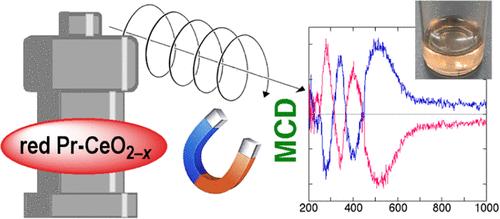高水分散性的镨掺杂氧化铈(PrxCe1-xO2−δ)纳米粒子:用MCD光谱研究pr相关光学跃迁的性质
IF 3.2
3区 化学
Q2 CHEMISTRY, PHYSICAL
引用次数: 0
摘要
在本文中,我们报道了缺氧条件下掺镨氧化铈纳米粒子的光学和磁光性质。PrxCe1-xO2−δ),可以通过常见的溶剂热方法合成。所得产物具有五彩纸屑状形态,具有较高的水分散性,呈淡黄色分散体。在600℃下热处理后,产物的高水分散性保持不变,使PCO纳米颗粒呈红色分散。根据退火后的PCO色散的光吸收光谱和磁圆二色(MCD)光谱,首次在350 ~ 650 nm范围内分辨出了导致红色的两种不同的光学跃迁。值得注意的是,由两个相互作用的法拉第b项产生的MCD信号可以清楚地识别出这些跃迁,因此可以将其归因于从已占据Pr4+ (4f)态的自旋轨道分裂带到未占据Pr4+ (4f)态的价带。我们相信,使用MCD的方法将是通用的,可以有效地揭示各种过渡金属氧化物纳米结构中与共价掺杂相关的光学跃迁的特征。本文章由计算机程序翻译,如有差异,请以英文原文为准。

Praseodymium-Doped Cerium Oxide (PrxCe1–xO2−δ) Nanoparticles with High Water Dispersibility: The Nature of Pr-Related Optical Transitions Studied by MCD Spectroscopy
In this article, we report optical and magneto-optical properties of praseodymium-doped cerium oxide nanoparticles with oxygen deficiencies (referred to as PCO; PrxCe1–xO2−δ), which can be synthesized by a common solvothermal protocol. The as-obtained products have a confeito-like morphology with high water dispersibility, showing a pale yellow dispersion. The high water dispersibility remains unchanged after thermal annealing of the products at 600 °C, giving a reddish dispersion of PCO nanoparticles. On the basis of both optical absorption and magnetic circular dichroism (MCD) spectra of the annealed PCO dispersions, two different optical transitions responsible for the red coloration are, for the first time, resolved in the region of 350–650 nm. Notably, the transitions can distinctly be recognized by the MCD signals with opposite signs arising from two interacting Faraday B-terms and thus would be ascribed to those from the valence band involving the spin–orbit split band of occupied Pr4+ (4f) states to the unoccupied Pr4+ (4f) states. We believe that the methodology using MCD will be universal to effectively unveil the characteristic features of aliovalent-dopant-related optical transitions in various transition metal oxide nanostructures.
求助全文
通过发布文献求助,成功后即可免费获取论文全文。
去求助
来源期刊

The Journal of Physical Chemistry C
化学-材料科学:综合
CiteScore
6.50
自引率
8.10%
发文量
2047
审稿时长
1.8 months
期刊介绍:
The Journal of Physical Chemistry A/B/C is devoted to reporting new and original experimental and theoretical basic research of interest to physical chemists, biophysical chemists, and chemical physicists.
 求助内容:
求助内容: 应助结果提醒方式:
应助结果提醒方式:


